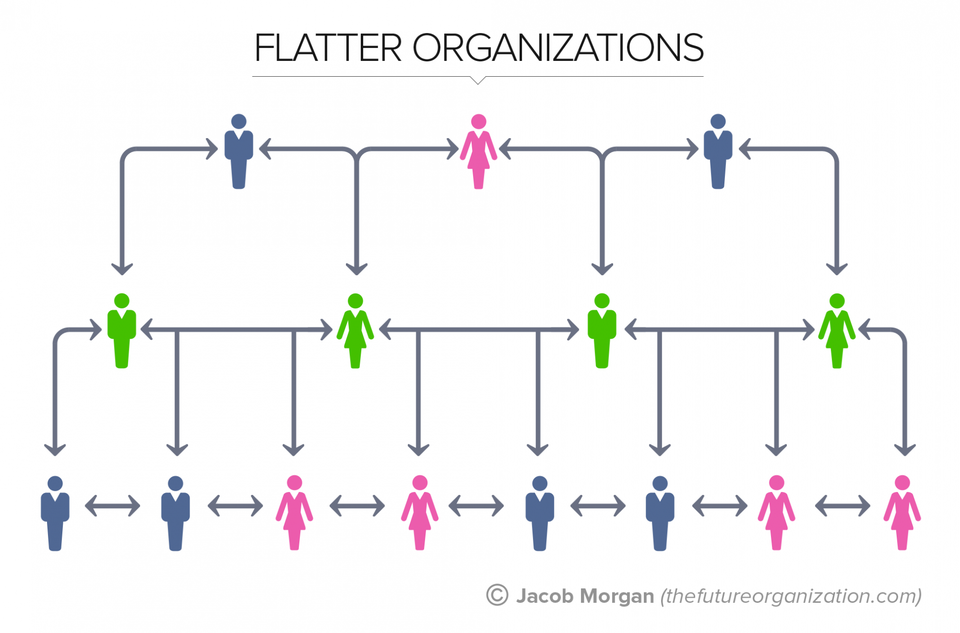1. Please provide leadership competencies/ Source for Chief Financial Officer (LSN) Overview: This leader oversees the day-to-day operations of the finance department. This leader is expected to aid i
Jul 8, 2015,12:08am EDT
The 5 Types Of Organizational Structures: Part 2, 'Flatter' Organizations

Jacob Morgan
Contributor
Leadership
I write about and explore the future of work!
This is part two of a five part post that explores various types of organizational structures that either already exist in today’s business landscape or are starting to emerge as viable options for the future of work. Each post will explore one of these structures and then I’ll provide a final summary post on all five. These concepts and ideas are taken from my book, The Future of Work: Attract New Talent, Build Better Leaders, and Create a Competitive Organization. The five types of organizational structures that I will explore are The traditional hierarchy (part 1 is already available)
Unlike the traditional hierarchy which typically sees one way communication and everyone at the top with all the information and power; a "flatter" structure seeks to open up the lines of communication and collaboration while removing layers within the organization. As you can see there are fewer layers and that arrows point both ways. Obviously an very simplified way to look at this type of a company but hopefully it gets the point across. For larger organizations this is the most practical, scalable, and logical approach to deploy across an entire company. This is the model that most large (and many mid-size) organizations around the world are moving towards.
It's true, some form of hierarchy still does exist within this model but that isn't necessarily a bad thing in this case. In flatter companies there is still a strong focus on communication and collaboration, improving the employee experience, challenging the status quo around traditional management models, and the like. But instead of completely reinventing the entire company and introducing a radical new structure and approach to work, it achieves similar results in far shorter term and with much less effort and resource allocation.
It's important to point that this type of model cannot exist without a few crucial things. The first is a robust set of technologies that act as the central nervous system of the company. These technologies help make sure that employees can collaborate and access each other and information anywhere, anytime, and on any device. The second thing this model requires is an understanding by executives and managers that employees don't need to work at your company, they should want to work there and as a result everything should be designed around that principle. The third thing that is required is an understanding that managers exist to support the employees and not vice versa. This also means that senior leaders focus on pushing the power of authority down to others instead of pushing down information and communication messages. The fourth and final thing I'll mention about this model is that the organization must accept that the way we work is changing and must therefore be comfortable with things like flexible work arrangements, getting rid of annual employee reviews, and challenging other outdated ways of working (there is more to be said about this but that's why I wrote a whole book on the subject!)
Companies like Cisco, Whirlpool , and Pandora , and many others are actively implementing this approach. I've interviewed executives at all of these companies and with the exception of Whirlpool have been inside of their offices. At Cisco for example employees have complete freedom and flexibility to work when, where, and how they want to work. At Whirlpool they got rid of traditional job titles and instead created four types of leadership roles that every single employee fits in. Whirlpool also has a robust innovation program that lets any employee contribute. Pandora has a whole team devoted to focusing on the employee experience which takes into account the values of individuals, the ways people work, and the physical environment that people actually work in.
This is the model I fully expect to see more of and based on the conversations and work I'm doing, this is by far the most widely adopted.
In part 3 of this post I'll explore the completely flat structure, stay tuned!
Jacob Morgan is a keynote speaker, author (most recently of The Future of Work), and futurist. To have Jacob speak at your event, to get access to his videos, podcasts and articles, or to subscribe to his newsletter you can visit TheFutureOrganization.

Jacob Morgan
Follow
Jacob is an Author, speaker and futurist. His latest book, The Future of Work: Attract New Talent, Build Better Leaders, and Create a Competitive Organization, explores…



